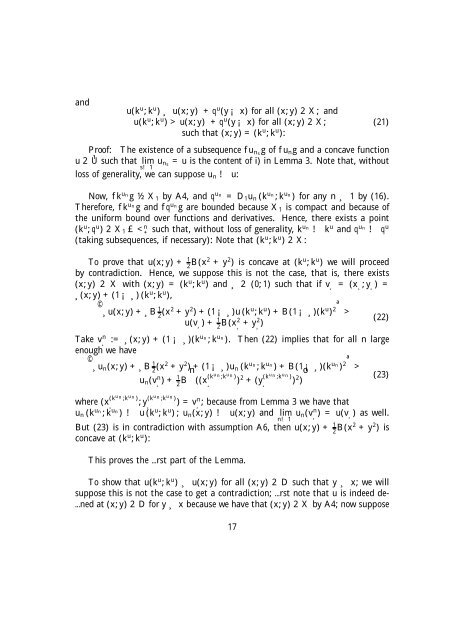Create successful ePaper yourself
Turn your PDF publications into a flip-book with our unique Google optimized e-Paper software.
and<br />
u(k u ;k u ) ¸u(x;y) +q u (y ¡x) for all(x;y) 2X; and<br />
u(k u ;k u )>u(x;y) +q u (y ¡x) for all(x;y) 2X;<br />
such that(x;y) 6=(k u ;k u ):<br />
(21)<br />
Proof: The existence of a subsequence fu ns g of fu n g and a concave function<br />
u 2 U ¹ such that limu ns =uis the content of i) in Lemma 3. Note that, without<br />
s!1<br />
loss of generality, we can supposeu n !u:<br />
Now, fk u n<br />
g ½ X 1 by A4, andq u n<br />
= D 1 u n (k u n<br />
;k u n<br />
) for anyn¸1by (16).<br />
Therefore, fk un g and fq un g are bounded becauseX 1 is compact and because of<br />
the uniform bound over functions and derivatives. Hence, there exists a point<br />
(k u ;q u ) 2X 1 £ < n + such that, without loss of generality,k un !k u andq un !q u<br />
(taking subsequences, if necessary): Note that(k u ;k u ) 2X:<br />
To prove that u(x;y)+ 1 2 B(x2 +y 2 ) is concave at (k u ;k u ) we will proceed<br />
by contradiction. Hence, we suppose this is not the case, that is, there exists<br />
(x;y) 2 X with (x;y) 6= (k u ;k u ) and ¸ 2 (0;1) such that if v¸ = (x¸;y¸) =<br />
¸(x;y)+(1 ¡¸)(k u ;k u ),<br />
1<br />
©¸u(x;y)+¸B<br />
2 (x2 +y 2 )+(1 ¡¸)u(k u ;k u )+B(1 ¡¸)(k u ) 2ª ><br />
u(v¸)+ 1B(x2¸+y2¸)<br />
(22)<br />
2<br />
Take v ņ := ¸(x;y)+(1 ¡¸)(k u n<br />
;k u n<br />
). Then (22) implies that for all n large<br />
enough we have<br />
©¸un (x;y)+¸B 1 2 (x2 +y 2 )+(1<br />
n<br />
¡¸)u n (k un ;k un )+B(1<br />
o<br />
¡¸)(k un ) 2ª ><br />
u n (v ņ )+ 1 2 B ((x (ku n;k u n)<br />
¸<br />
) 2 +(y (ku n;k u n)<br />
¸<br />
) 2 (23)<br />
)<br />
where(x (kun ;k un )<br />
¸<br />
;y (kun ;k un )<br />
¸<br />
)=v ņ ; because from Lemma 3 we have that<br />
u n (k un ;k un ) ! u(k u ;k u ); u n (x;y) ! u(x;y) and lim u n (v ņ ) = u(v¸) as well.<br />
n!1<br />
But (23) is in contradiction with assumption A6, thenu(x;y)+ 1 2 B(x2 +y 2 ) is<br />
concave at(k u ;k u ):<br />
This proves the …rst part of the Lemma.<br />
To show thatu(k u ;k u ) ¸u(x;y) for all(x;y) 2D such thaty¸x; we will<br />
suppose this is not the case to get a contradiction; …rst note thatuis indeed de-<br />
…ned at(x;y) 2Dfory ¸xbecause we have that(x;y) 2X by A4; now suppose<br />
17

















